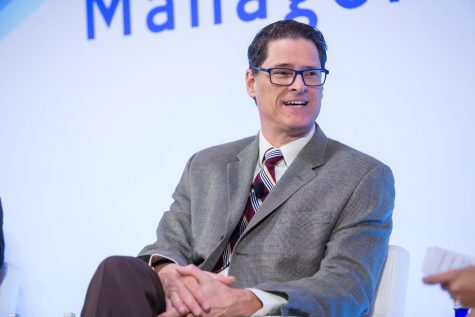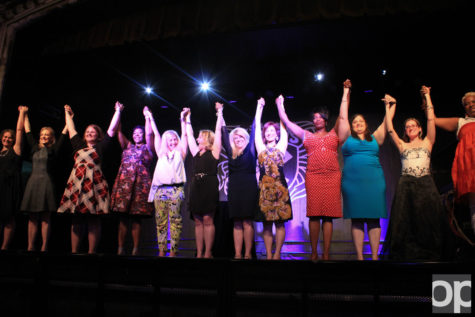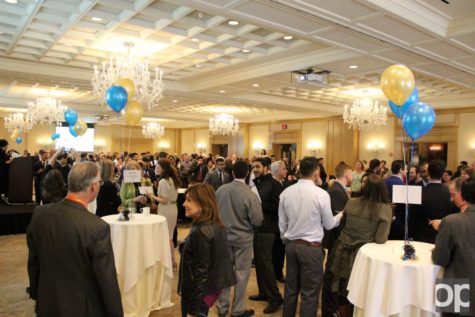Prof. Brian Connery
By TIM RATH
Web Editor
What are your plans for this summer? Will you be slingin’ hash at your latest summer job, going back home to get reacquainted with your parents’ curfew policy, or trying to figure out how many peanuts you can stuff in your mouth during one-half inning of a Detroit Tigers game? (My current record is 78.) If you’re Oakland University English professor Brian Connery, you will be doing none of those things and thankfully so.
Connery teaches the British Studies at Oxford program at Oakland University, which will send students to Brasenose College at Oxford University in Oxford University for one month this summer. Connery will be teaching a survey of British literature course while guiding students through a maze of British history including National Theatre, the British Museum, the Imperial War Museum, the British Library, and Christ Church College; optional excursions available to Stonehenge, Salisbury Cathedral, Avebury, Warwick Castle, Blenheim Palace, and the city of Bath.
Registration for the class is currently closed, read on anyway. Connery’s way with words may well incite you to cross the pond and get to know your British neighbors before next summer’s (almost assuredly) failed Tigers’ season.
1. What classes do you teach?
Regularly, I teach intro to Shakespeare, the survey of British literature (“from Beowulf to Virginia Woolf”), eighteenth-century British literature, and, more recently, a survey of Irish literature. Irregularly, I teach courses on satire, the eighteenth-century novel, and comedy. On the basis of some of the discussions we had in my satire class last semester, I’m thinking about a course on happiness literature.
2. Who in your field inspires you to teach?
I’m not sure, at this point, exactly what my field is, but most of the literary scholars I’m inspired by have both extraordinarily comprehensive literary historical minds (i.e., they’ve read a lot) and areas of expertise which they’ve pursued to a degree of detail that might at first seem trivial. Even in areas like literary or critical theory, I tend to be attracted to theorists who’ve read broadly and historically — people like Northrop Frye, or Stephen Greenblatt, or Margaret Doody — rather than narrowly and “theoretical subtle and nuanced.” My own mentor, Doug Canfield, specialized in Restoration drama (i.e., roughly 1660 – 1699) and not only had read but knew all of the more than a thousand plays published or staged in London over those thirty-nine years. It took him decades to reach that level of expertise, and only when he had reached it did he really begin to publish his research. He wrote and published three books in the last eight years of his life, before he was unexpectedly afflicted with pulmonary fibrosis and died. He was correcting the galleys on an article up to the day before he died. I admire him.
3. What is on your reading list?
Right now I’m on sabbatical and my reading list is as long as my arm. And reading lists have a way of leading to more reading lists which is where I’m at just now. I’m working on a book on Jonathan Swift and also reading more generally about eighteenth-century English and Irish lit. For a little while, I was reading Maria Edgeworth books intensively: she wrote in Ireland at the end of the eighteenth-century, while I was catching up on recent criticism of Jonathan Swift’s works. Then I came across a set of works that I’d never heard of before. John Dunton was a late 17th and early 18th-century journalist and bookseller, who was most famous for putting out a magazine called the Athenian Mercury, which I knew about and had read some of. The idea of the magazine was that a group of wise and knowledgeable men (the Athenians) met in London weekly to discuss and answer questions that were sent in by readers, and then these answers were published in the magazine. It was all a fraud — Dunton wrote almost all of it, i.e., most of the questions and all the answers. As a young man, Jonathan Swift (like his employer, Sir William Temple) was taken in by the magazine, and one of his first poems was an “Ode to the Athenian Mercury” which he sent to the “Athenians” and which was published in one of the issues. Swift himself became a master of hoaxes, and I’ve wondered if there’s a connection to his being taken in by Dunton.
4. Could you describe what you do at OU in one sentence?
I make knowledge, spread it around, and try to help people see how cool it is.
5. What is your favorite OU sport to watch live?
Women’s basketball — probably because I know more players on that team than on the others, though I guess I know a bunch of swimmers, runners, and softball players too.
6. It’s lunchtime and you’re hungry. Have you packed your own lunch, are you going to the OC or are you ordering out?
I don’t know anymore. I used to pack my lunch and eat in the “lounge” when the English department was in Wilson Hall. It was a great experience, and I learned a lot (and had a lot of laughs) from my colleagues. Now we’ve moved and have tried to create a little facsimile, but it’s not quite the same.
7. How is your office looking? In other words, if I were a student who had an appointment, would I be able to see around the piles of papers?
Not a good question to ask right now. Papers are graded, and returned or shredded — no problem. But I’m about four bookshelves and two filing cabinets short in my current office, so it’s hard to walk around among the books and file folders on the floor.
8. When is bedtime?
10:30; I get up at 5:30 and, during the school year, spend the first three hours of the day getting my two kids up, breakfasted, and out the door to school while trying to take care of email and sometimes working out a little.
9. Where is the most interesting place your studies have taken you?
For me, that means mostly what library do I like most. I’ve worked in the Clark Library (LA), the Huntington Library (Pasadena), the Newberry (Chicago), the Beinecke (New Haven), the Folger (DC), the old British Library (London), the Lambeth (London), the Bodleian (Oxford), and Marsh’s (Dublin), I like Marsh’s the best, even though it doesn’t have a lot of stuff that’s useful to me. Narcissus Marsh, the Archbishop of Dublin, in the late 17th-century decided that Dublin needed a library which, unlike the library at Trinity College, would be open to the public, and he went about acquiring the best and most important books available at the time. He got lots of Korans and Middle Eastern works, as well as the most important European scientific works (he found first editions of Copernicus and Galileo) and a lot of travel books. By the time he was done, Dublin had the best public library in Europe. Fortunately or unfortunately, they didn’t acquire any more books after about 1740, so what you’ve got there is a time capsule of the state of knowledge in Europe in 1740. And it’s still in basically the same condition as it was in the eighteenth-century: a lot of the books are still chained to the shelves, and the Keeper of the Library, Muriel McCarthy, may lock you into the space between the shelves where you’re reading if she doesn’t trust you. She’ll also show you the signatures of a lot of Dubliners who used the library at one time or another, including James Joyce and Oscar Wilde. Marsh’s is conveniently located next to St. Patrick’s Cathedral, where Swift was the Dean for more than 20 years, and so I get to pop in to Marsh’s whenever there’s a Swift conference at St. Patricks.
10. What do you hope students know before they take your class(es)?
How to turn off their cell phones, which end of a baseball cap is the front, and who has the right of way: an aging professor carrying thirty pounds of books and student papers in a pedestrian crosswalk in a heavy rain, or an SUV. If they’ve got those three things down, we’re good.







